Blog
July 6th, 2012
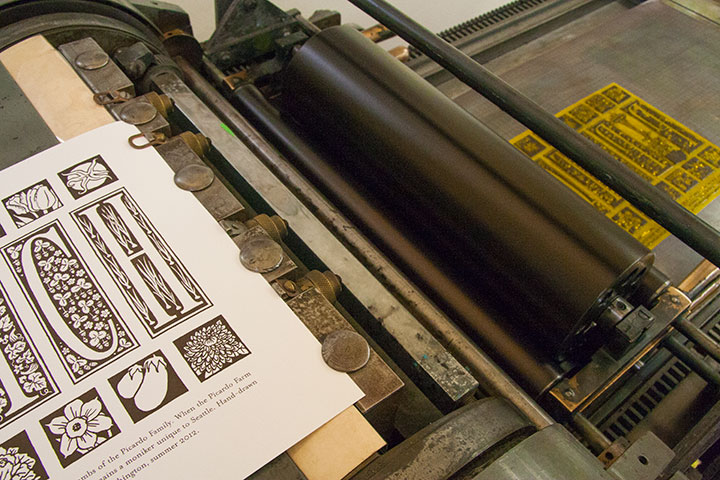
I’m working on a little something in Jessica’s studio right now.
Something that’s making me downright hungry.
I’ll show you the finished product as soon as it’s done—provided I don’t go bury my head in the veggie crisper first!
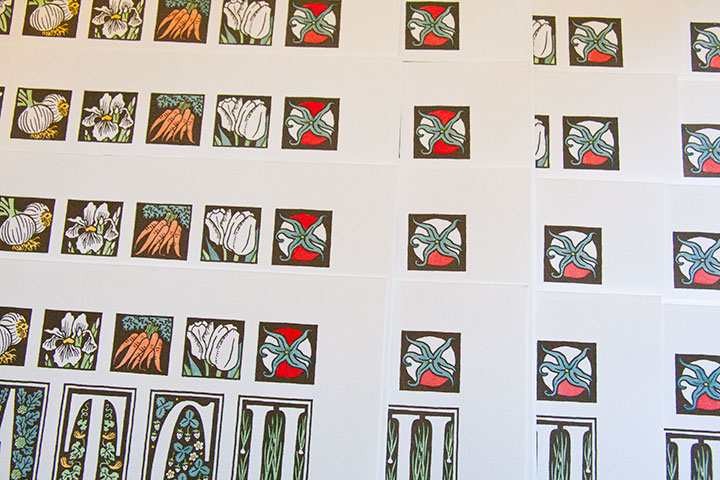
June 29th, 2012
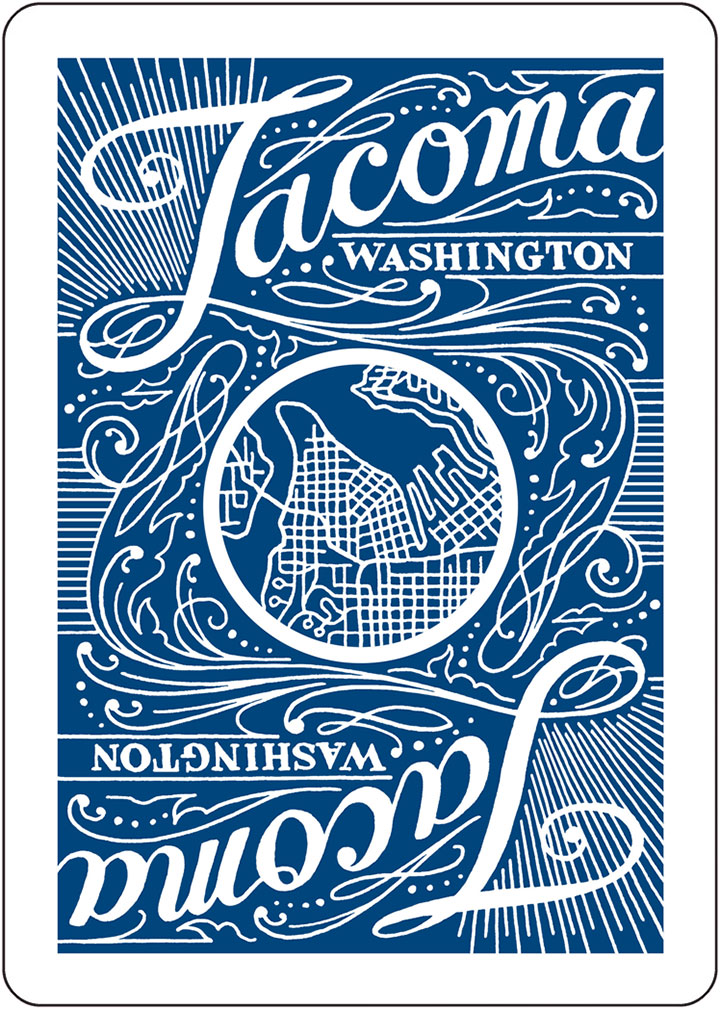
My brain is chock full of useless information—I could sing you about 35,000 ad jingles on key, or recite Jurassic Park or Trading Places or a hundred other movies line-for-line. But don’t challenge me to a game of Poker, because I have a terrible head for card games. I love playing them, and am always up for learning when friends come over a suggest a rubber of something or other. The trouble is, I forget the rules right away—so whenever I sit down to a rematch, it’s like starting at square one.
As an example, I used to do summer stock theatre, and we techies had a tradition of playing Hearts backstage during the sound check. So I played Hearts every night for two months straight, three summers in a row, and I still can’t remember the rules now. (Something about being saddled with the Queen of Spades, and lots of half-joking shouted epithets surrounding that card, but that’s about it.)
Over the years I have learned and forgotten dozens of card games—including Snap, President, Pitch, Five Card Draw, Seven Card Stud, Crazy Eights, Kings Corners, Egyptian Ratscrew, Spades, Slapjack, Pig, Cheat, Five Hundred, Hand & Foot, Whist—and probably plenty of others that I’ve even forgotten the name for.
About the only games I can ever keep in my head are the embarrassingly simple ones like War, Go Fish, Old Maid and Blackjack. Oh, and I can play Cribbage like a fiend, because my dad and his Scottish friend Alex taught me when I was nine or ten. We used to have hilariously cutthroat wee-lass-vs.-grown-man Cribbage tournaments on a regular basis, so how could I ever forget that?
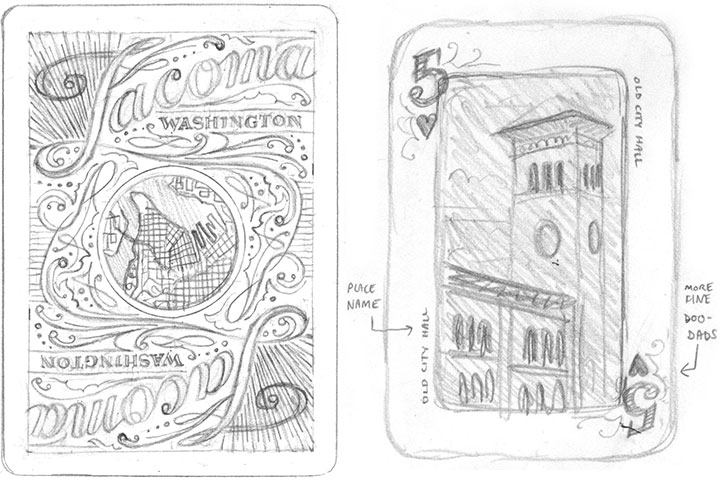
Being lousy at remembering any card games, however, hasn’t stopped me from wanting to design a card game. Or collecting interesting or unusual decks (the Tailor and I have a good dozen in regular rotation). So when my friends Maija and Amy asked me to be the designer on the poker deck they were dreaming up, I think must have freaked them out by shouting, “YES!” before they’d even finished their sentence.
(And as an added bonus, I got first dibs on my favorite Tacoma haunts.)
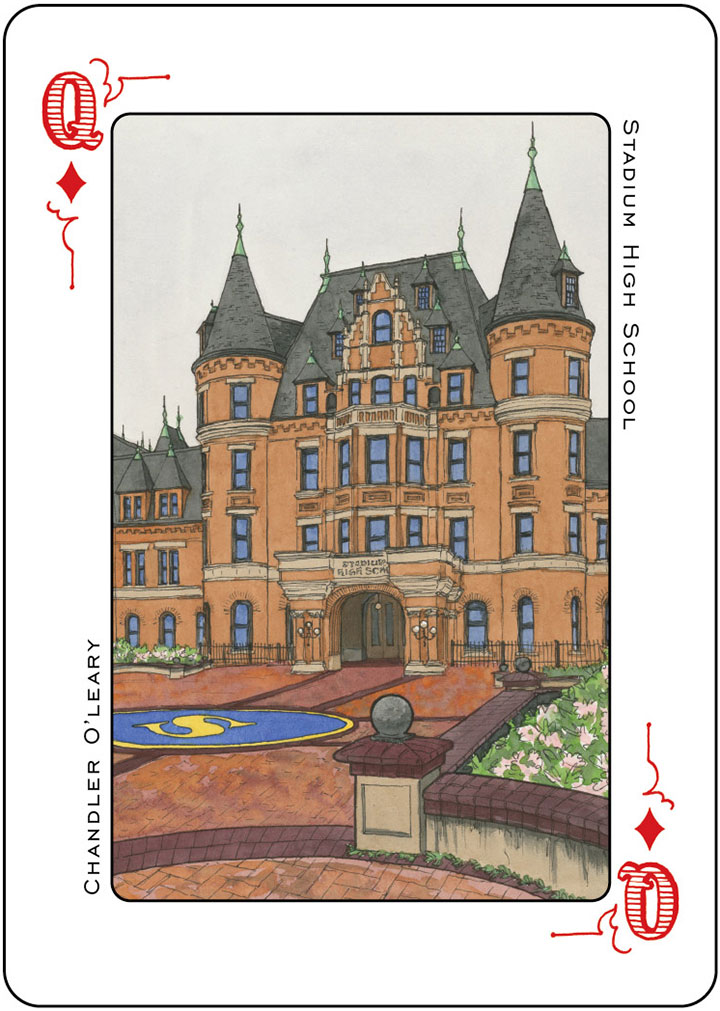
These gals weren’t looking for any old run-of-the-mill card deck, either. They wanted to show off Tacoma in all her architectural splendor. And since we’re blessed with a veritable boatload of fabulously talented artists in this town, they decided to divvy up the deck by ranks—with fourteen artists, each tackling a list of locations in four-of-a-kind fashion. I loved being the first to see the collection of incredible artwork come down the pike from these folks. Everybody involved in the project has gone above and beyond our wildest imagination—I can’t wait to see the finished deck.

Beyond just creating something beautiful and fun, Amy and Maija have their eyes on a bigger prize. They want to create a real, no-kidding Tacoma souvenir. We get a lot of visitors and tourists around here, what with the Sound and the Mountain and the Universities and what-have-you—but you’d be hard-pressed to find Tacoma-specific tchotchkes (or even postcards!) that aren’t sarcastic. And I know I’m not the only one around here who’s a little tired of folks knockin’ T-town, based solely on a stereotype and a thirty-year-old reputation. So we’re upping the ante a little, and offering a bit of hard evidence that Tacoma is pretty dern great.
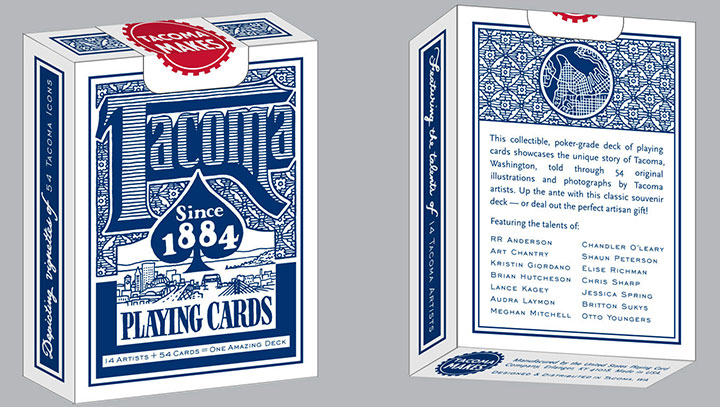
You know my schtick by now, so you can guess that all the lettering and pattern doo-dads are hand-drawn. I had the pleasure of designing the suits, rank typography, card face template, card backs and box.
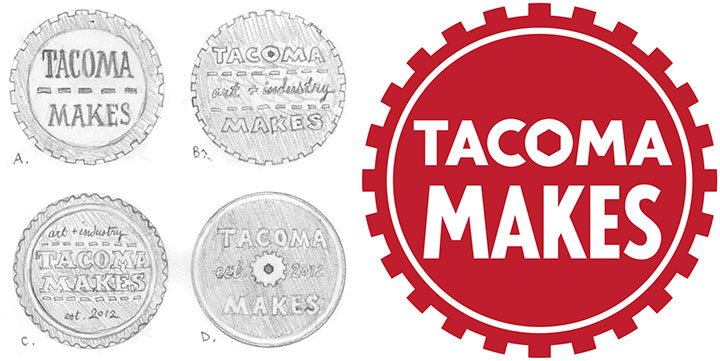
I even got to design the logo for Maija and Amy’s company, Tacoma Makes. Basically, it was the kind of project I’m always on the lookout for, but which rarely lands in my lap. So I spent about half of the time grinning my fool head off, and the other half pinching myself in disbelief.

I also got to flex my file-production muscles. I love to geek out over the technical side of design, but since I started my business, much of my production work has centered around letterpress printing. So playing with dielines and spot color swatches again was a nice little challenge.
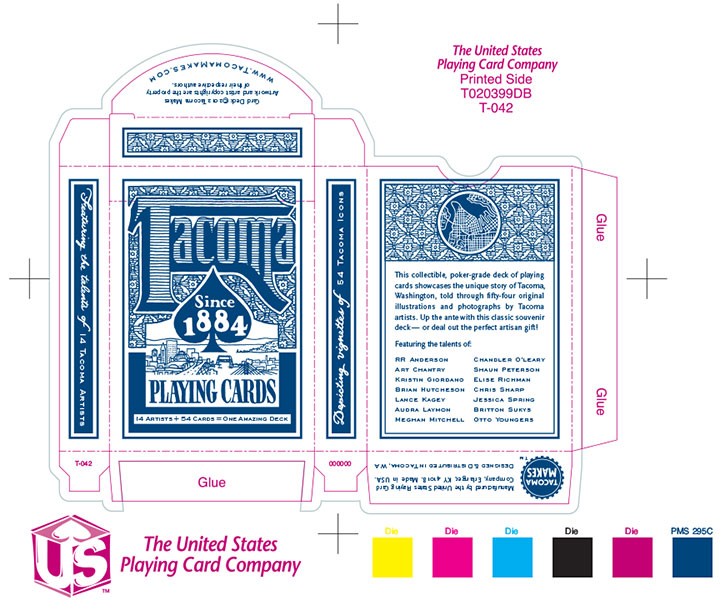
We’re taking all these extra steps because this is a real, bona fide, professional-grade poker deck. The kind folks at the U.S. Playing Card Company are manufacturing the cards for us—they’re the people behind the Bicycle, Bee, Hoyle and other card brands. So you won’t have to hedge your bets that this deck will be extra tasty.

To raise funds for the card printing, and even pay for modest artist contracts, we set up a Kickstarter project (much like the Apocalypse Calendar that you all so graciously funded last year). Now normally this would be where I explain that Kickstarter projects are only funded if they reach their entire monetary goal by the deadline—but I don’t have to! I left town for a few days, just after the project launch, with the intention of spreading the word when I got home. So imagine how floored I was to come back and discover that we’d met our goal in just six days!
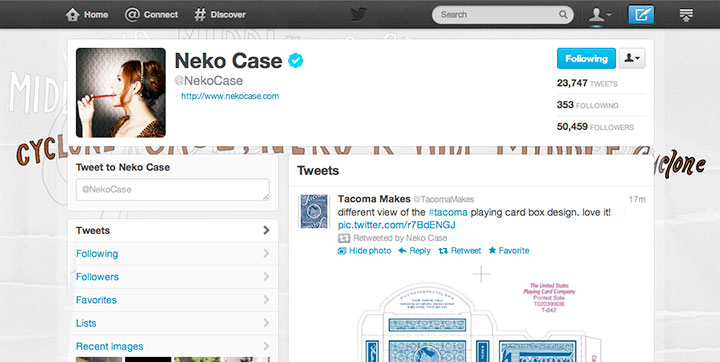
The response to this has been staggering. And it’s not only the lovely legions of fellow Tacomans who have supported us—we’re seeing pledges come in from all over the country. And as a nerdy fan-girl aside, I just have to squeal and tell you that Neko Freaking Case (a hometown Tacoma gal) has been retweeting my designs in the Twitterverse. Dorky internet hero fantasy: fulfilled, folks.

The Kickstarter project will run through July 19, so you can still contribute if you want to get in on rewards and goodies that are only available to backers. Otherwise, the cards will be in hand and dealt out this November—along with an exhibition of all the original artwork.
There’s even a rumor of an artist game night in the works, so cut the cards! I’m up for any game you’re willing to teach me—as long as you don’t mind that I’ll probably forget the rules before the night is through.
In the meantime, thank you so much for all your support for our crazy card deck! I’ve said it before, and I’ll say it again—Tacomans (and honorary Tacomans!) are the best folks on earth.
• • • • • • • • • • • • • • • • • • • • • • • • • • • • • • • • • • • • • • • • • • • • • • • • • • • • • • • • • • • •
Edited to add (fall 2013): The blue deck has been so popular that we have done a red deck as a sequel! The new deck features all new artwork and artists—you can read more about it here.

June 20th, 2012

I’m helping some friends of mine cook up a big ol’ basket of hometown pride. That’s all I’ll say for now, but we’ll be ready to spill the beans next week.
It’ll be worth the wait, I promise.
June 1st, 2012
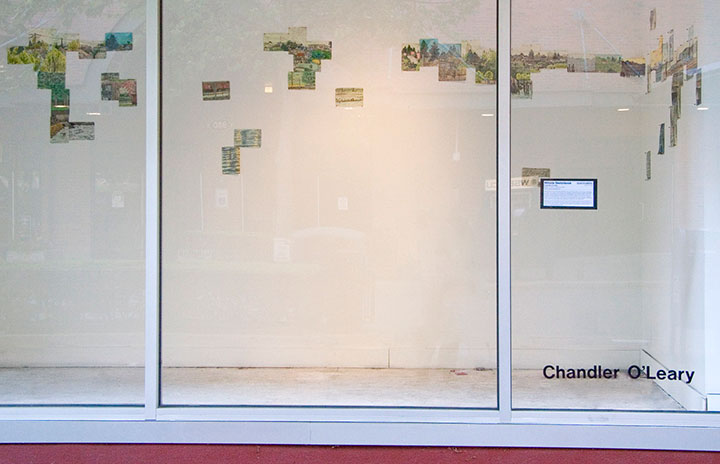
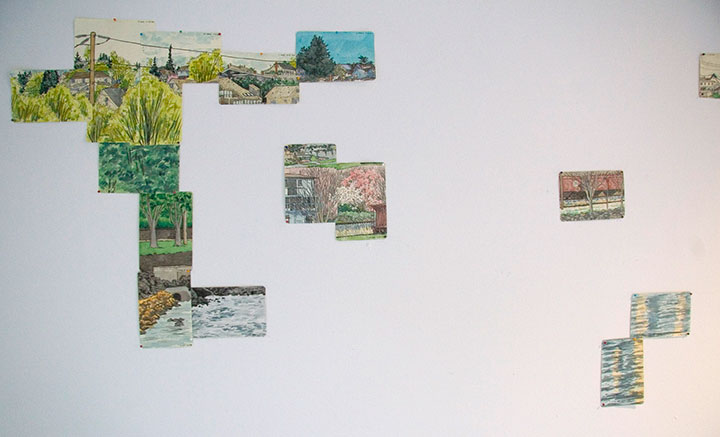
In case you haven’t seen it yet, my Hillside Sketchbook installation is coming along nicely! The scene will keep growing and shifting all this month, before the exhibit ends on June 30. Swing by the Woolworth Windows at 11th and Broadway in Tacoma, and catch it while you can. (Hint: it’s especially fun during the Farmers Market on Thursdays!)
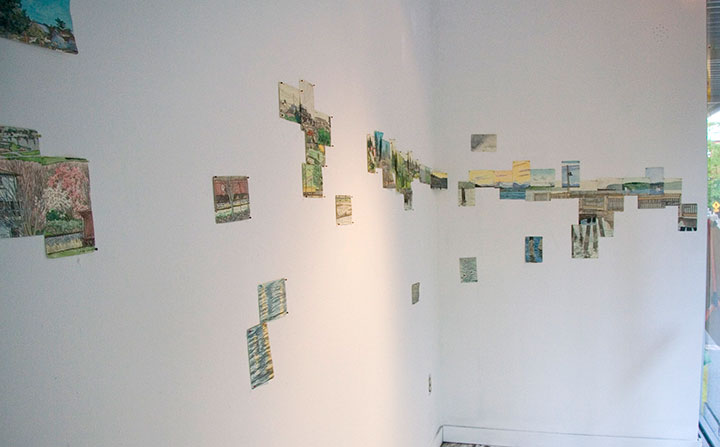
April 23rd, 2012
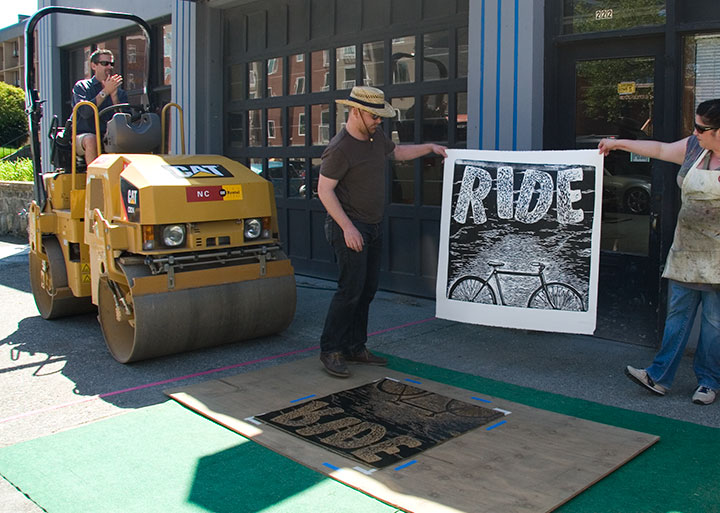
Oh, man. I’m beat. You people plum wore me out this time. Every year I keep thinking we can’t possibly top the previous one, but Wayzgoose just keeps getting better and better. And this year, the weather was so unbelievably good* that I think half of Tacoma (plus a good portion of Seattle and a smattering of Portland) put on their walking shoes and marched into our midst.
*See all those pairs of sunglasses? That straw hat? You don’t see those much ’round these parts. We’re the pasty-rainy vampire people, remember? Sunshine in April = naw, son, you must be dreaming.
To put it another way: it was absolute crazy sauce.
Or maybe it was just that the word is fully out now about our little printers’ party. After all, the Weekly Volcano said last week, “There are otherwise button-down, Wonder-bread, vanilla South Sounders who lose their ever-lovin’ shizz over Wayzgoose.” Amen, bros.
Big thanks to everyone who showed up to the party (even if I didn’t get a chance to thank you in person); to the Tacoma Arts Commission for being our fairy godparents; to the small army of adorable volunteers who kept everything chuggin’ along; to Rosemary Ponnekanti at the News Tribune for the write-up; to Kyle Durrie for making an appearance in her travelin’ Type Truck; and to sweet pea Flaherty and Jessica Spring for making it all happen.
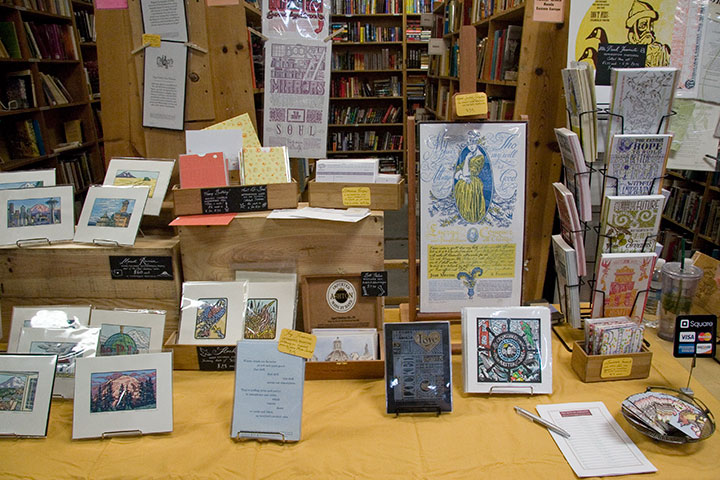
Speaking of Jessica, I think I laid eyes on her all of twice, all day. She was scurrying around and herding cats outside, while I was camped behind a steady stream of folks at our adjacent tables (thanks, y’all!). There wasn’t even room to sneak a hip shot of how many people were shoehorned in there, so the only photos I could snag were right at the beginning before folks showed up, or at the end, when people finally started to clear out.
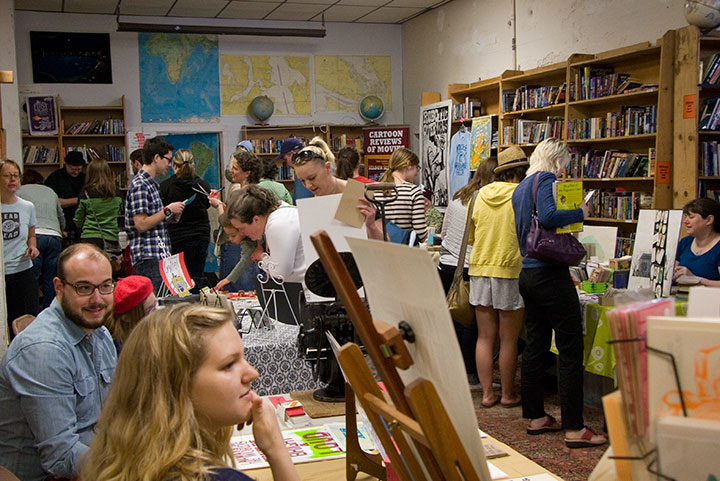
I know this doesn’t look like a big crowd, but trust me—it was a total sardine can in there. (Or clown car, if you prefer circus metaphors. I know I do.) But when the room is packed with all your favorite Northwesterners, it’s a win-win.
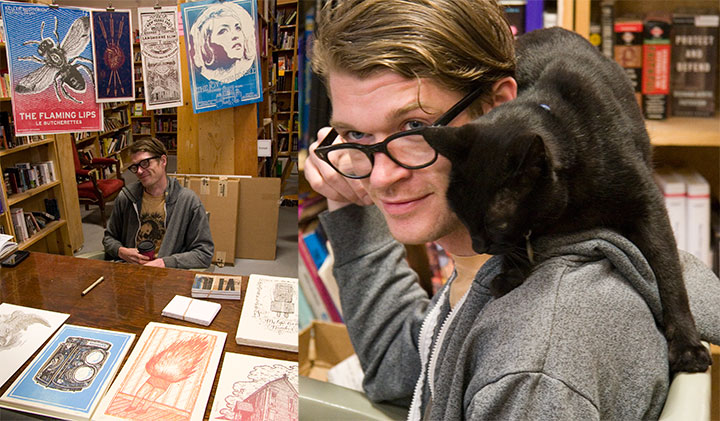
Among the talented regulars was my lovely friend Keegan (and of course, Atticus, who frequently thinks he’s a pirate parrot. Yarr!).
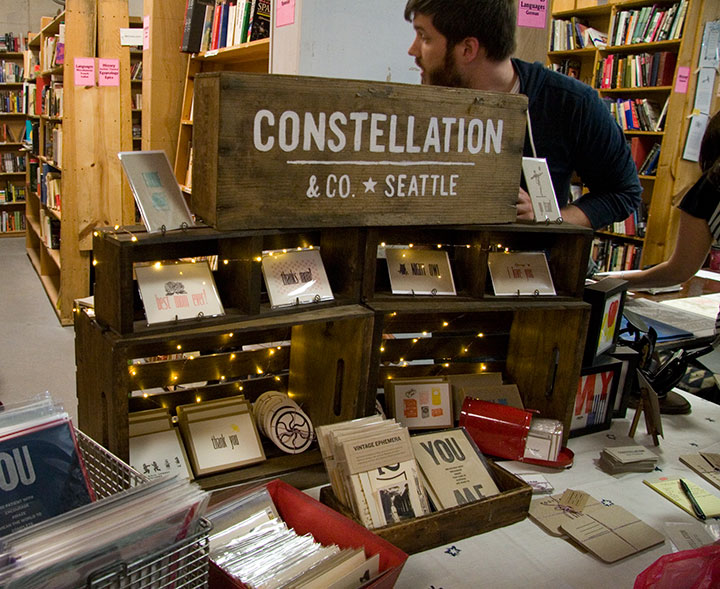
There was also a very special newcomer this year. My former student Sara caught the letterpress bug, and caught it bad. In less than three years since she took my class, she and her husband Brad (pictured) have gone from newbie nestlings to fully-fledged, successful business owners. Sigh. My kids are all grown up and making a hand-printed ruckus! It does my heart good.
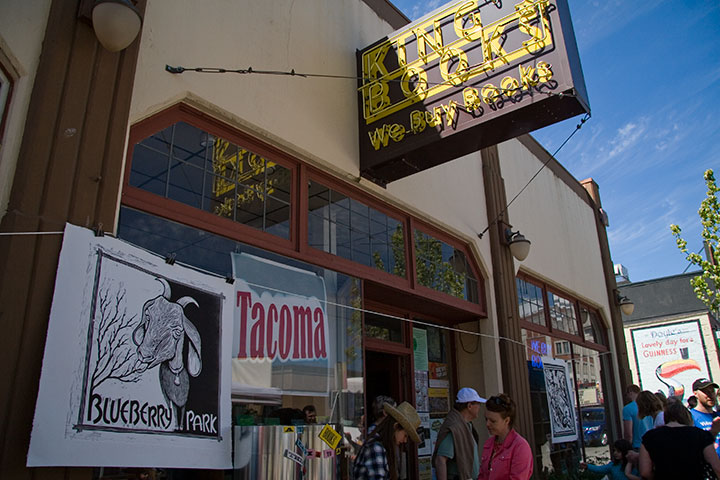
Outside, the steamroller prints were better than ever. (Special shout-out to Audra Laymon for her goatey Blueberry Park print! I think a hundred people heard me squeal when I saw it.)
Jessica and I decided to sit out the steamroller this year to make room for a few new folks, and that turned out to be a smart move. Just standing at my table for six+ hours hobbled me like an arthritic old woman—I don’t think my knee would have been up to printing. My only regret was not being able to witness much of the spectacle this year.
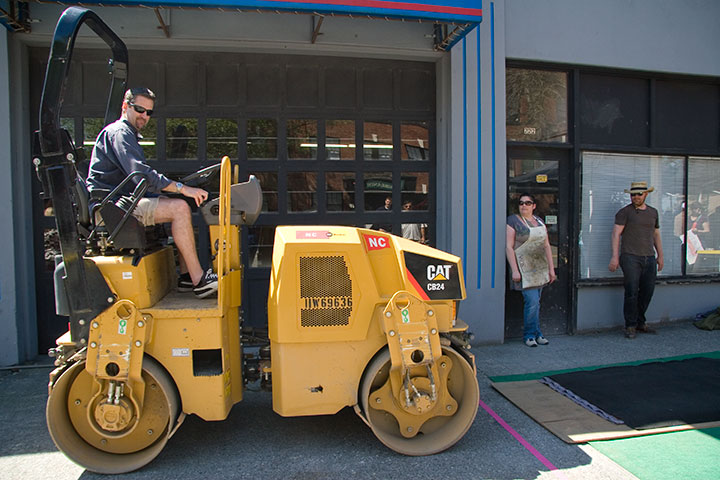
I did sneak outside long enough to learn that Tacoma’s own Arts Commissioners had been pressed into service (heckuva job, Scott!)—
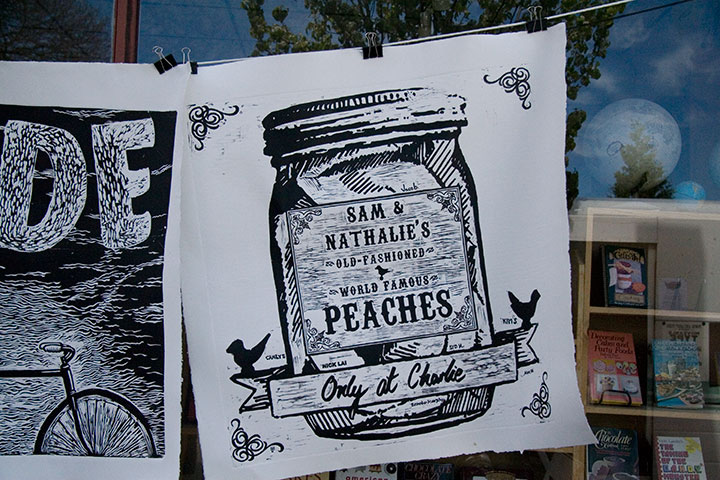
and that the print quality was the tastiest it’s ever been, thanks to some tweaked techniques Jessica gleaned from our day in San Francisco last fall.
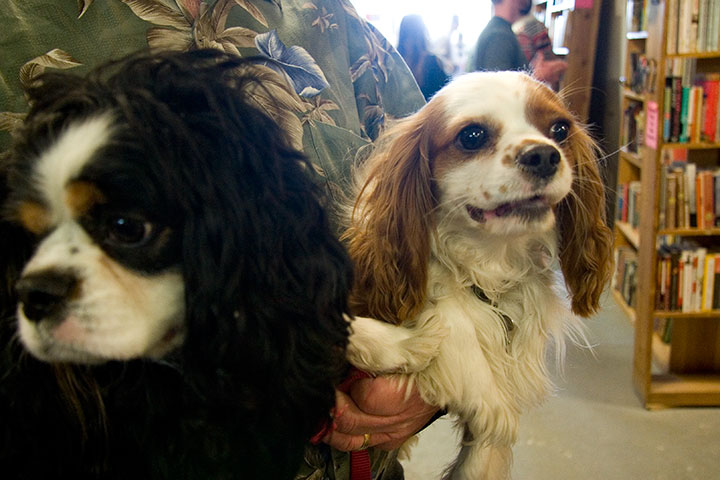
Attendance reached a new record this year—I think we’re an official Tacoma institution now. Mr. sweet pea says the count of men, women, children, babies and beasties approached the 1,000 mark!
(R.J. says: Word to your mother.)
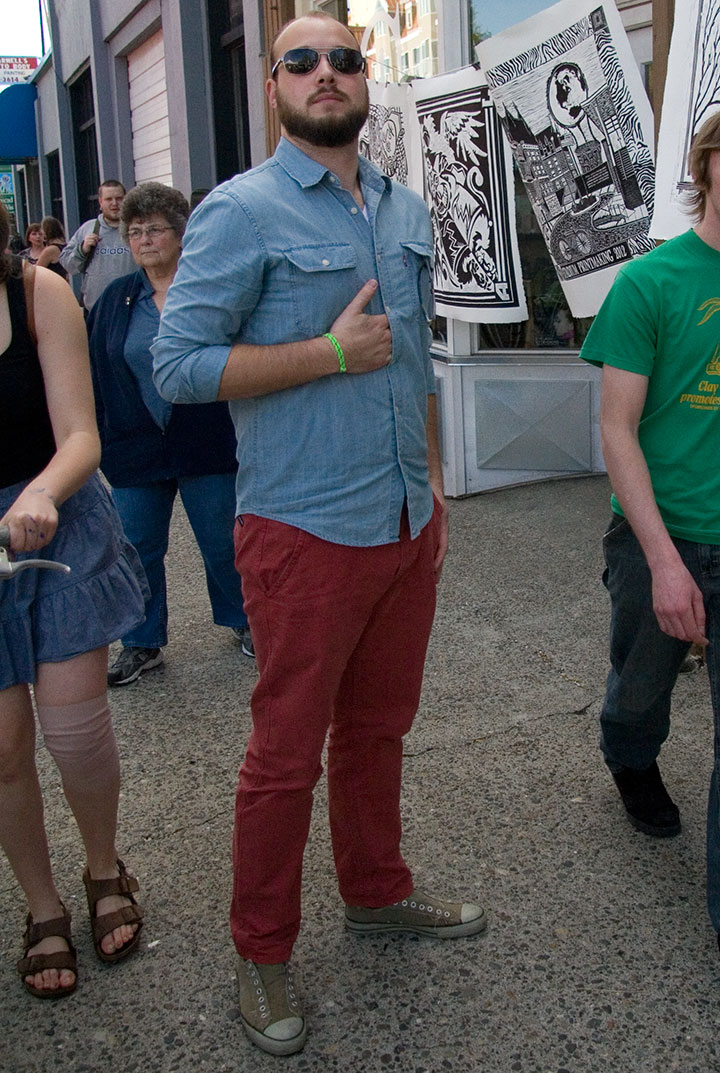
April 6th, 2012
Last Sunday, to raise funds for the upcoming Wayzgoose, we had a little “Wayz & Means” film festival celebrating all things letterpress. Even though the show’s over, the main event of Wayzgoose itself is still on deck. So as a little warm-up to get you in the printing mood, I thought I’d share a couple of the films we featured.
First up is an animated short I first saw over a year ago, at the Codex Bookfair in California. I’m pleased to announce that Old Time Film, by Barbara Tetenbaum and Marilyn Zornado, is finally viewable online! So let’s get this party started:
Oh, man. I love that. If you want your very own copy of the film (trust me, you do—there’s a little making-of featurette on the DVD), you can purchase it here. No, Barb and Marilyn aren’t paying me to hawk their movie—I’m just a believer, that’s all.

I’ll leave you with one of my very favorite episodes of The Twilight Zone, circa 1963, where a gleefully terrifying Burgess Meredith gets a newspaper job as the world’s fastest linotype caster. There’s a catch, though: Mr. Smith has a secret. To get in on it, you need to understand the little letterpress inside joke behind the episode’s title.
You see, a typesetter’s inky hands (and quite possibly the inflammatory writ published by the early masters) earned printing the moniker “the Black Art.” So there are all sorts of clever nicknames to go with that title. For instance, a letterpress apprentice was called a “printer’s devil,” and old, broken type gets thrown in the “hell box” to await being melted down. The list goes on.
Get it yet?

Well, watch and you’ll see what I mean. (Gaah! That face.)
Da, da, daaaaaa!
Join us on April 22 for the Wayzgoose, and get in on the devilish fun.
Eighth Annual Wayzgoose
Sunday, April 22 • 11 am to 4 pm • Free!
King’s Books • 218 St. Helens Ave. • Tacoma, WA
In the meantime, I’m going to practice lighting cigars with my index finger.
April 4th, 2012
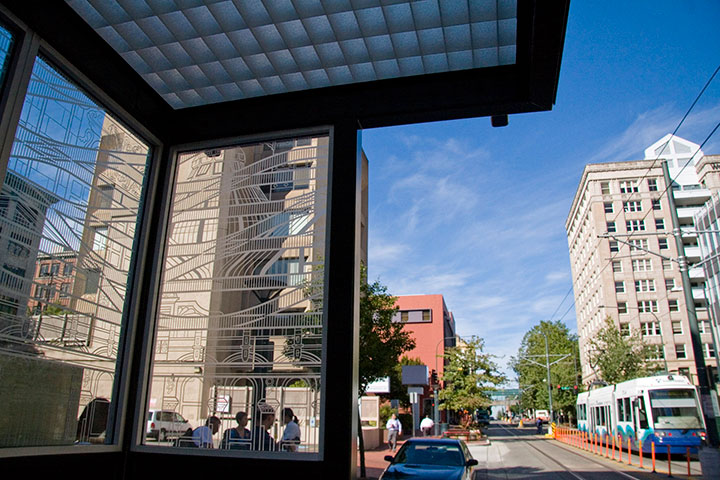
This is rather old news now, but as it took such a long time to complete, and as it isn’t exactly going anywhere, being hot off the press doesn’t matter so much. Last year I was commissioned to do a piece of public artwork here in Tacoma, and as of a few months ago, the Commerce Street light rail station is up and running.
I’ve done several temporary and permanent public pieces before, but this was my first commission for a durable materials project—and by that I mean materials that can be expected to last many decades with minimal maintenance (metal, stone, concrete, ceramics, glass, etc.). Interestingly, painted murals are not considered durable; they require all kinds of upkeep, and have an average life expectancy of only five to ten years.
The Commerce Street Station project called for a design for etched glass. Now, as you’re well aware, I’m no glass artist—it’s a little weird to think of a letterpress printer doing glass work. But that’s the beauty of the public art realm: instead of one artist tackling every aspect of a project, there’s a whole team of people involved, each focused on his or her particular strengths. I was responsible for the design, and industrial fabricators took care of the actual glass-etching part. So what my part boiled down to was a process nearly identical to what I do for any letterpress print: a hand-drawn illustration, converted into a computer file for production. Realizing that created a huge mental shift for me, and suddenly made the prospect of wearing a Public Artist hat way less intimidating.
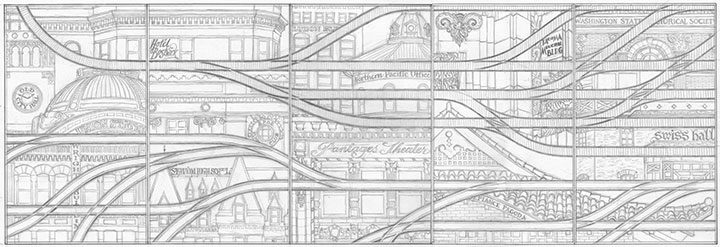
If you’ve ever stood in a shelter waiting for a bus or train, you’ve probably seen an etched glass design. Usually it’s an abstract pattern to discourage graffiti, or in the Pacific Northwest, often something outdoorsy or salmon-themed. So I figured that territory was well covered. Instead, I focused on the rails themselves. The railroad is possibly the single most significant aspect of Tacoma’s history; it is truly the backbone of our city. In 1873, Tacoma was chosen over Seattle as the terminus of the Northern Pacific Railroad. Without the resultant growth and industry that resulted from the railroad hub, Tacoma might still be a tiny fishing hamlet, rather than a bustling port.
For decades, industrial and passenger rail travel was our pride and joy. Along with the goods and people moving along the NP Railroad line, Tacoma was also criss-crossed with streetcar lines, providing efficient and comprehensive public transportation. During the Great Depression, however, the cost of maintaining the streetcar lines became too heavy a burden. The system was dismantled in 1938, and private automobiles became the dominant mode of transportation. This story is by no means unique — passenger rail fell out of favor all over the country, and today, public rail transit is only the norm in our largest cities.
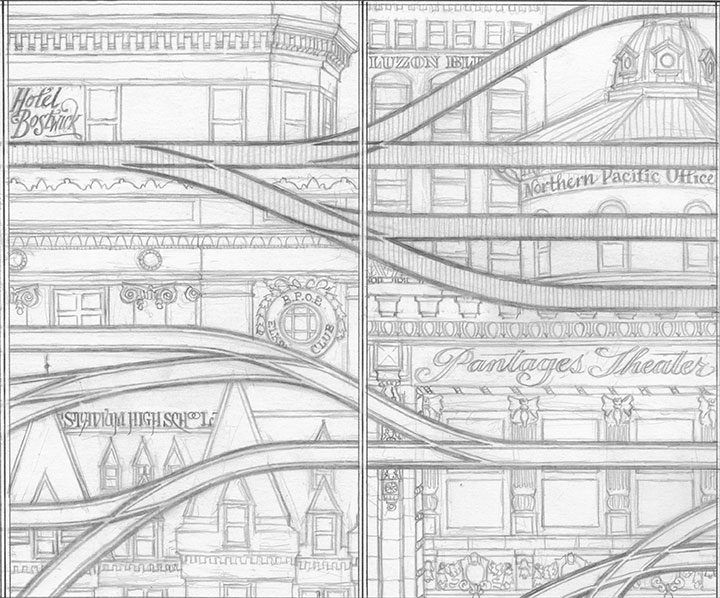
To me, our small (but expanding) light rail line is a ray of hope for a progressive future, a return to a more sustainable system, and a chance to highlight Tacoma’s history. So for Continuum, I designed a brace of parallel rail lines. The top line is a set of traditional railroad tracks, beginning as a single thread and branching outward—symbolizing Tacoma’s beginnings and expansion. The bottom tracks are grooved-rail embedded tram tracks—exactly the type you see in both old streetcar lines and modern light rail paths. As the traditional tracks branch outward, the tram tracks converge into a single path, just as our lone light rail line is the last vestige of the old streetcar network.
Tacoma’s architecture sprouted and developed right alongside the railroad, as a result of our industrial growth. So instead of surrounding the tracks with a white-noise pattern of ballast, like you’d see around real tracks, I designed an illustrated amalgam of our most iconic buildings. Some are still with us; others are long gone (can you spot the Luzon Building above?). Every structure represented exists either along a historic streetcar or other track line, or has some connection with the railroad.
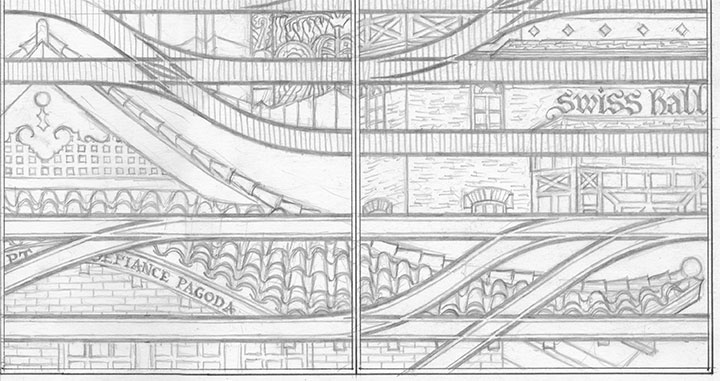
While I was working on the initial design, a teenage arsonist set fire to the historic Pt. Defiance Pagoda. Suddenly it didn’t seem to be enough for the city merely to preserve the architecture—I felt the need to create my own record of as many buildings as I could.
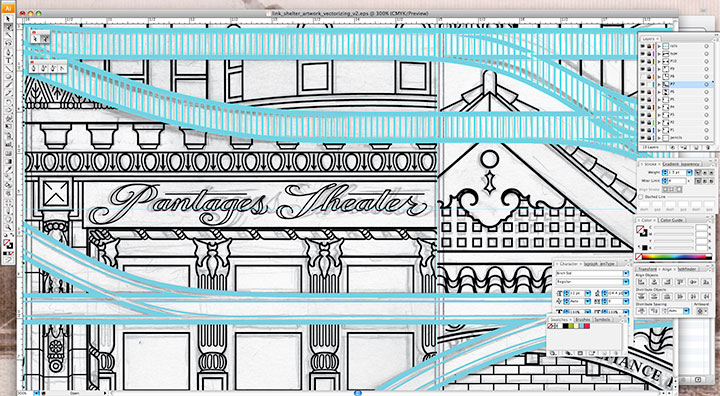
My pencil drawings weren’t finished enough to send to the fabricator—I needed to bridge the gap between my pencil and their equipment. To get the artwork to the point where it could be etched into glass, I needed to convert it to a specific file format called vector graphics. Now, digital photos are made up of pixels: a grid of tiny dots that determine how large a size an image can be blown up to be. The more pixels per square inch, the larger you can make the photo. Vector art doesn’t work like that. Without getting in over my head in explaining this, vector graphics are made of math.
(Which is super cool, really.)
The shapes are determined by geometric points, lines and proportions, rather than pixels. So that means you can blow the artwork up to any mammoth size, or shrink it as small as you please, and you’ll never lose detail or image quality. This makes the vector format A) awesome; and B) ideal for translating extremely intricate work into industrial materials. All I had to do was fire up Adobe Illustrator, and get to work converting the artwork.
This took days. And days. And days.
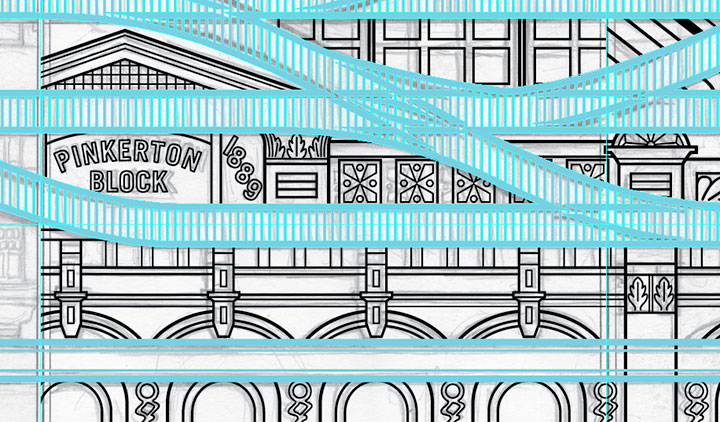
It’s funny that people tend to see computer programs as shortcuts or “cheats,” but in the end, any good piece of digital artwork requires a level of craftsmanship—exactly the way a handmade object does. Illustrator has lots of labor-saving tools if you know where to look, but the ones that are designed to fully automate the conversion from a scanned drawing to a vector file aren’t always ideal. For this particular project, the only way to do it right was to suck it up and spend ungodly hours redrawing the thing “manually” within the program. I had to rely on all my artist chops just as much for file production as I do for any artist book or watercolor painting. I easily spent as much time converting the design to vector format as I did drawing it by hand, but it’s important to have a flawless file—lots of expensive production steps are dependent upon that file being free of glitches or stray marks.
As an aside, one night that I stayed up (very) late working on the file happened to be the night of the Royal Wedding. To provide some background noise (in order to stay sane), I streamed the event in a little window on the corner of my screen while I worked. So now, whenever I see the finished glass panels I think of ridiculously ornate English hats, and the Queen in her vanilla Jello pudding-colored suit. Pavlov would have a field day with me.
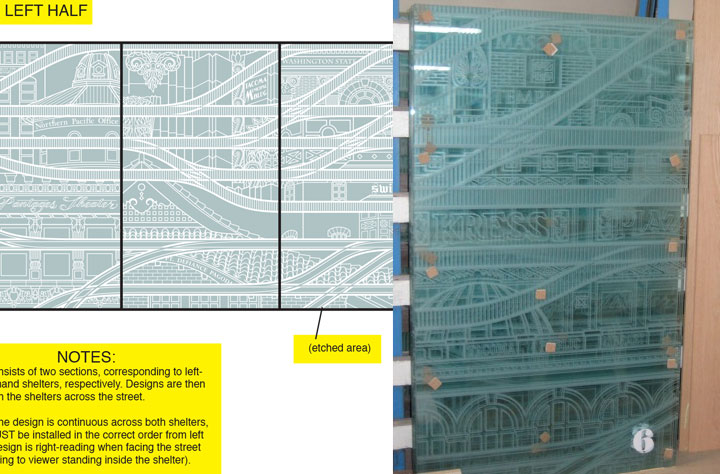
Right-hand photo courtesy of City of Tacoma
Anyway, next I sent the finished files to the fabricator. Using the points plotted in the file, and a digital mockup I threw together with my production notes, they were able to cut the design out of a masking material, which they attached to the glass. Then the sand-blasted the glass panels. Where there were holes cut through, the sand made contact and etched the glass; everything protected by the mask stayed shiny and transparent. The finished result is a clean, precise replica of my design.
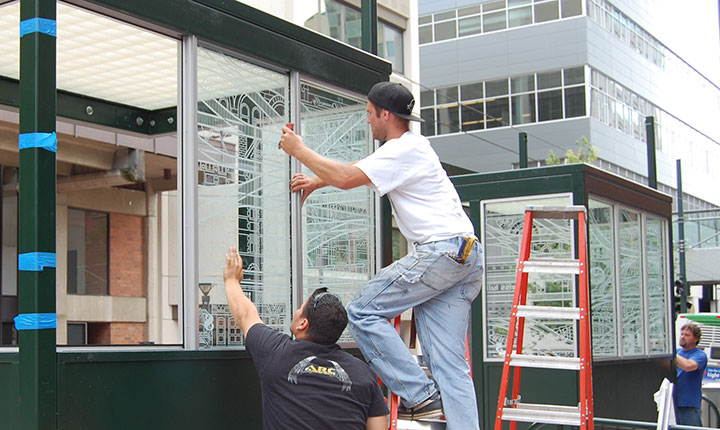
Photo courtesy of City of Tacoma
The tricky part was making sure they installed all ten panels in the correct order; otherwise the connecting track lines wouldn’t make sense. Thanks to the big fat numbers they stuck to each panel, though, everything worked out just fine.
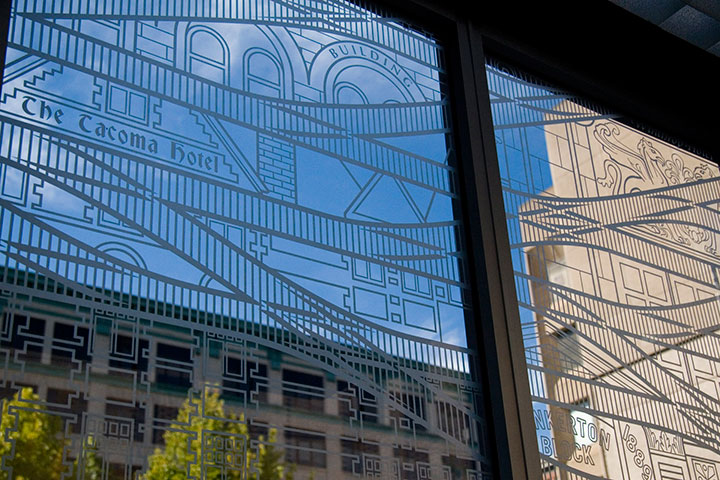
It’s fun to stand inside the finished shelter, and see the stylized buildings contrast with real ones. And when you’re not paying close attention to the details, the illustrations recede into a sort of geometric pattern.

For those who are paying attention, my hope is that this little illustrated city will encourage viewers to notice the real city around them—preferably with an eye toward preservation and innovation.
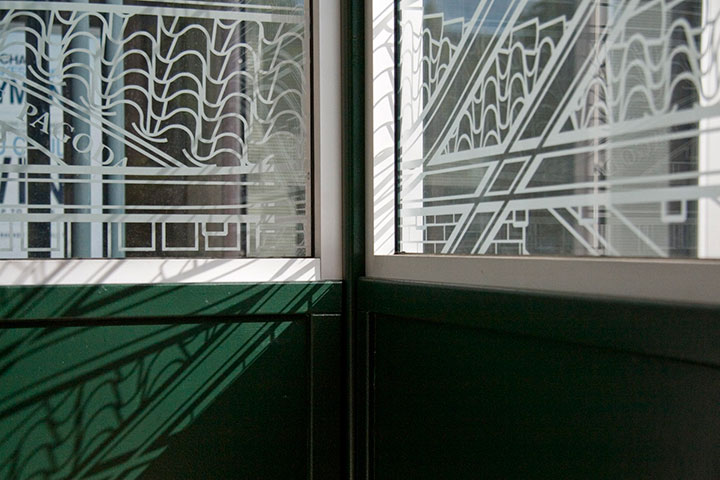
Attentiveness has its own little reward, too. If you happen to be there when direct sunlight hits the glass, the etched lines project onto every surface. (Tacoma looks good on you.)
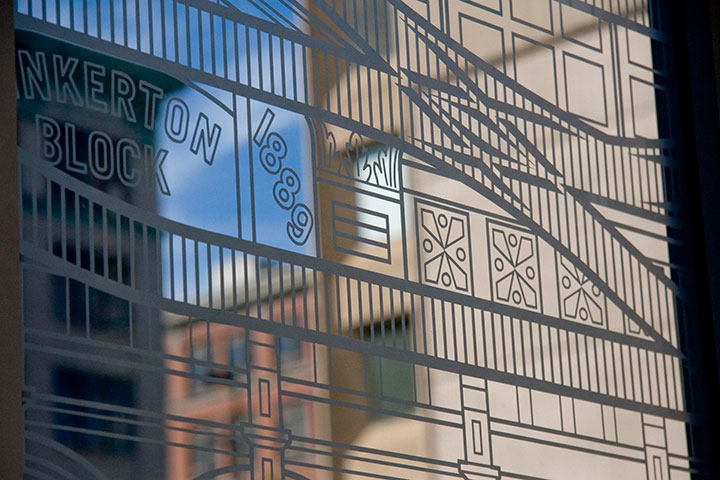
In the end, I just wanted to take the dull routine of waiting for a train, and turn it into something beautiful—even if only for a moment.
I’m always saying things like, “If I ran the world…”, usually followed by some crazy idea for transforming every mundane thing in life into something a little more meaningful. I love the thought that on one tiny patch of real estate, I really did get to run the world, and make things exactly the way I imagined they could be. Many thanks to Amy McBride and the City of Tacoma for giving me free rein.
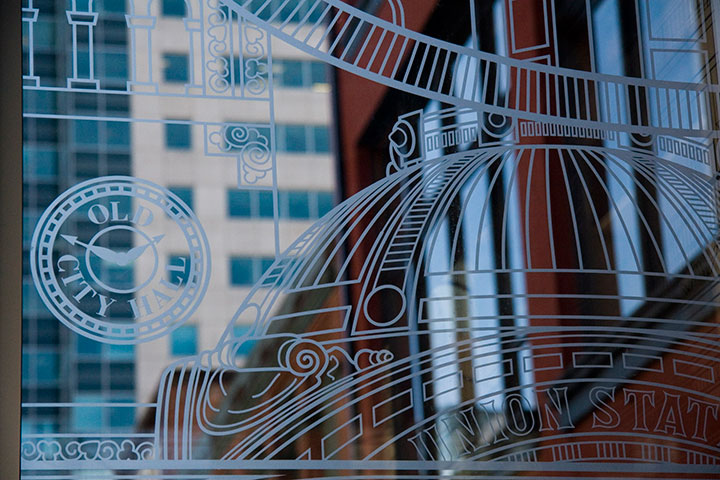
March 26th, 2012
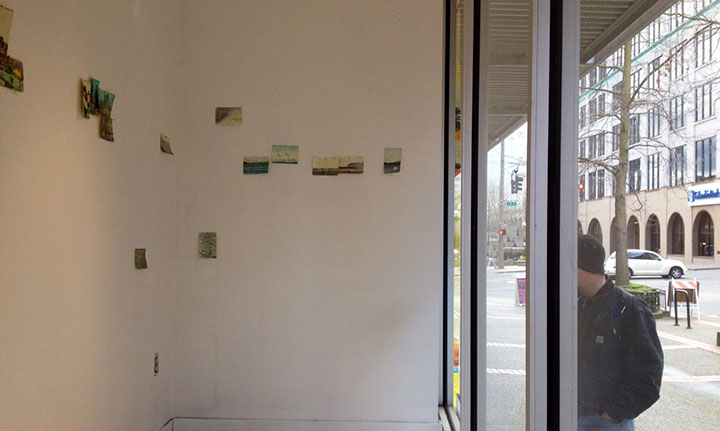
In between a whole host of deadlines I’m juggling at the moment, I’m exhibiting in the Woolworth Windows again, thanks to Spaceworks Tacoma.
Hillside Sketchbook
Artist book installation by Chandler O’Leary
On view through June 30
Woolworth Windows at 11th and Broadway
Downtown Tacoma, WA
Like last time, I’m creating an installation that comes together in real time. This time, though, I’m not painting in a glass box—I’m doing one huge drawing of a Tacoma hillside that’s made up of many dozens of tiny watercolor sketches. The sketches are done on different days, in all weather conditions and through changing seasons, and are tacked up in the window as they’re finished. The scene grows and takes shape like a puzzle being put together piece-by-piece. So go take a look—and come back often. Tacomans: can you figure out which viewpoint I’m drawing from?
I’ll be posting more photos here as the installation comes together. In the meantime, check out the post about the project on the Spaceworks blog.
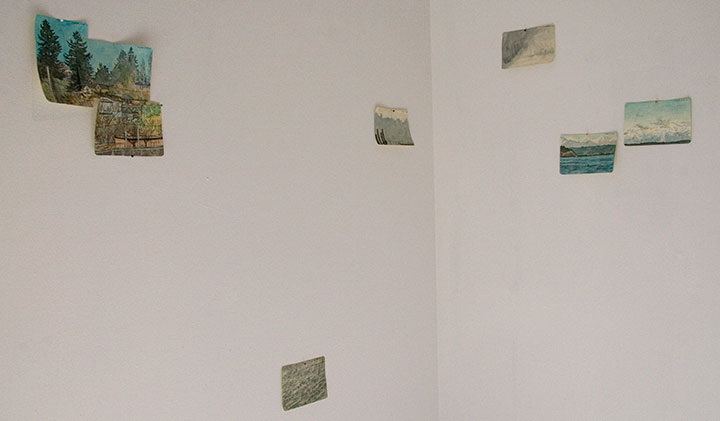
February 4th, 2012
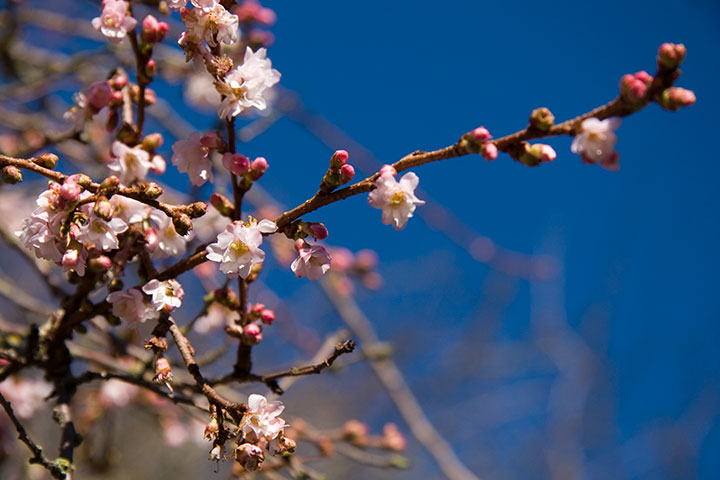
And just like that, the season turns. I don’t know what that Punxsutawney Phil guy thinks he knows, but his predictions rarely apply here. Spring comes early in the Northwest, and yesterday I spied this little harbinger of good things to come. I’ll take the predictions of the trees over any prognosticating rodent.
The sun’s returning in earnest now, too—not just with this batch of unexpected blue skies we’ve had lately, but with noticeably longer days. Everyone here is just a little more cheerful as a result. Suddenly, everywhere are smiles and open windows, as we all breathe in that first hint of fresh spring air.
January 18th, 2012
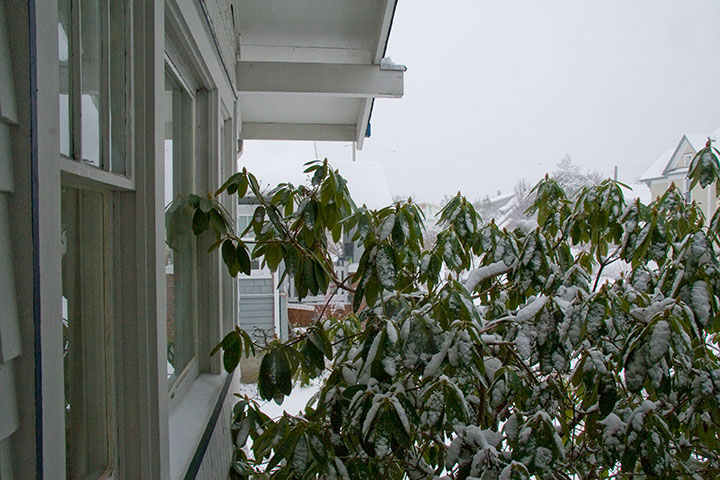
I’m not the only one who’s housebound today.
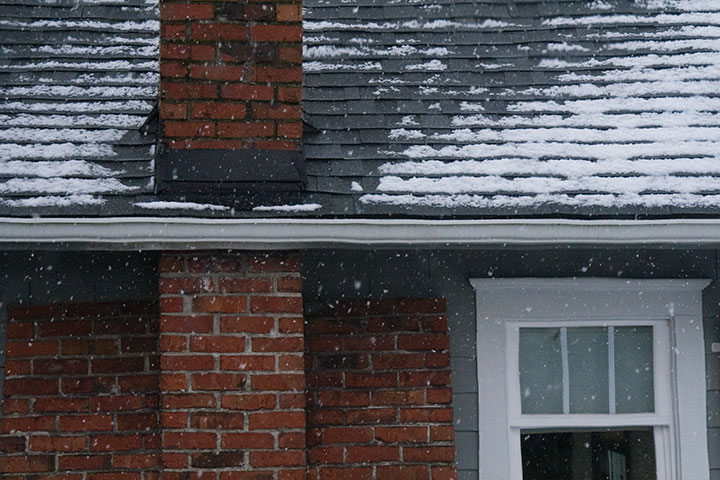
Winter finally remembered us, and for the last four days the snow has been swirling.
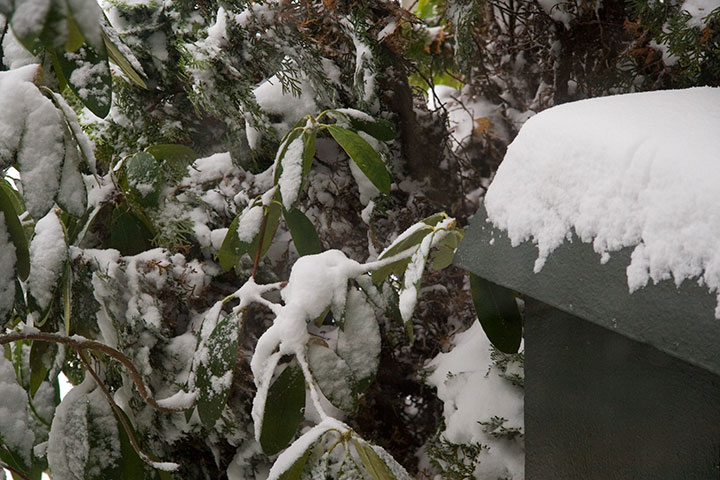
Today we woke up to a proper blanketing.
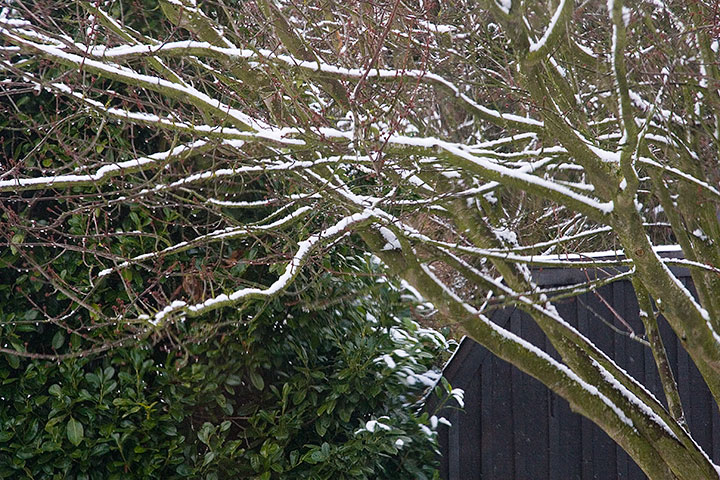
So all over town, people are staying home, and watching through their windows—just like I am.
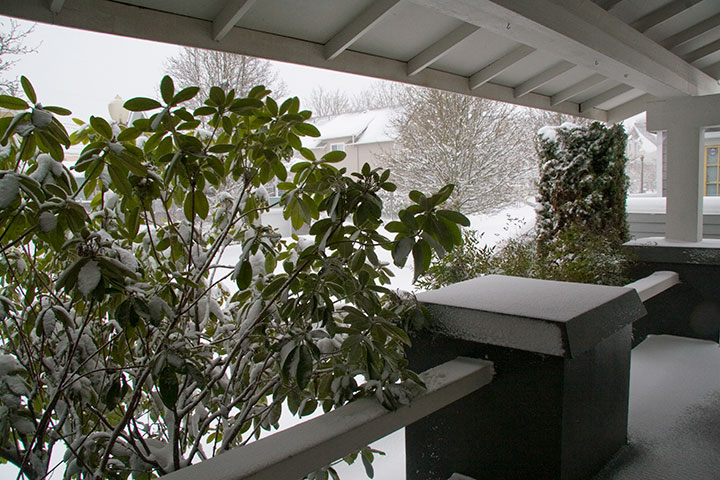
Thank you to everybody who commented, emailed, called, tweeted, sent cards and packages, delivered chocolate, or dropped by to keep me company. Your kindness has been so wonderful, so warming. I’m doing fine, for the most part, and though we don’t have all the answers yet, what we do know is there are no broken bones or anything really scary. I go back to the doc on Friday, and hopefully we’ll have a proper diagnosis then, as well as a plan for what comes next.
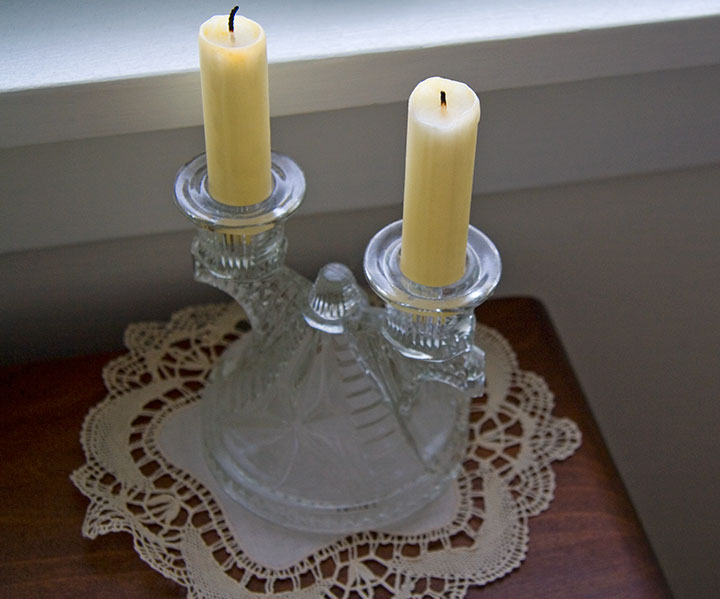
Until then, I’m here, waiting in the white.

![Chandler O'Leary [logo]](https://chandleroleary.com/wp-content/themes/chandleroleary/images/logo.png)


















































